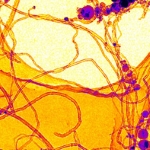Nanomaterials Centre (Nanomac)
Australian Institute for Bioengineering and Nanotechnology and School of Chemical Engineering, The University of Queensland
Formerly known as ARC Centre of Excellence for Functional Nanomaterials
The Nanomaterials Centre’s work is focused on the development of a large variety of functional nanomaterials for applications in clean energy, environment and health. The Centre is an interdisciplinary research centre with research expertise in chemical engineering, chemistry, electrochemistry, materials science and engineering, nanotechnology, catalysis, and materials chemistry and physics.
- Website
- https://nanomaterials.centre.uq.edu.au/
- Organisation type
- University research centre
- Cooperative Research Centre – partner organisation
- Number of research staff
- 20-100 research staff
- Address
- AIBN, Building 75, Cnr College and Cooper Roads, The University of Queensland, St Lucia QLD 4072
Strengths and capabilities
- New catalysts for solar fuel generation
- New generation high performance rechargeable batteries
- New generation of low cost solar cell materials
- Gene/drug delivery and imaging
- Nanocatalysts design for sustainable green chemicals
- New photocatalysts for air/water pollotant removal
- New reaction system/device for CO2 reduction
Facilities and major equipment
- Rechargeable battery assembly and testing instrument
- Elemental and Thermal Gravimetric Analysis instruments
- Catalysis product characterisation and analysis (GC, HPLC)
- X|ray powder diffraction analyzer
- Zetasizer Nano (zeta potential, particle size distribution)
- Gas adsorption analyzers (4) for porosity and surface area analysis
- Solar cell assembly and efficiency testing system
- UV|VIS Spectrophotometer / Fourier transform infrared spectroscopy
- Multiple wet chemical synthesis and high temperature furnaces
- Physical Containment Class 2 (PC2) laboratory
Lead researchers
- Professor, Centre Director, ARC Future Fellow Lianzhou Wang—Expertise in semiconductor materials for energy application, over 230 journal papers, 12 patents, and more than 30 grants
- ARC Future Fellow, Associate Professor Gordon Zhiping Xu—An expert in layered materials for biomedicine and environment applications with over 200 journal papers and more than 20 research grants
Achievements of the centre
- A novel photochemical-chemical loop for the overall Hydrogen Sulfide (H2S) splitting was developed for solar energy utilization, which has been selected as a HOT paper by Angewandte Chemie International Edition
- A new photocatalytic system based on vertically grown hematite nanosheet was developed for solar energy conversion, published on Advanced Materials
- A new type of photoelectrode with n-type to p-type switchable semiconducting properties was developed, shedding light on the potential photo-electronic applications of n–p switchable devices.
Key science sectors
More information about the sectors this centre is involved in:
Update details
Is this your centre? See any issues? Send a request to update your listing.
